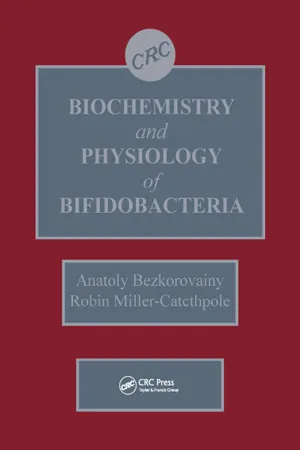Biological Sciences
Bifidobacterium
Bifidobacterium is a genus of bacteria that is commonly found in the gastrointestinal tract of humans and other animals. These bacteria are considered beneficial and are often used as probiotics to promote gut health. Bifidobacterium species are known for their ability to ferment carbohydrates and produce lactic acid, which contributes to a healthy balance of microorganisms in the gut.
Written by Perlego with AI-assistance
Related key terms
2 Key excerpts on "Bifidobacterium"
- eBook - ePub
Lactic Acid Bacteria
Microbiological and Functional Aspects
- Gabriel Vinderola, Arthur Ouwehand, Seppo Salminen, Atte von Wright(Authors)
- 2019(Publication Date)
- CRC Press(Publisher)
9 Bifidobacteria General Overview of Ecology, Taxonomy, and Genomics Chiara Ferrario, Francesca Turroni, Douwe van Sinderen, and Marco Ventura CONTENTS 9.1 General Features 9.2 Ecology of Bifidobacteria 9.2.1 Human Intestinal Microbiota and Role of Bifidobacteria 9.3 Genomics and Bifidobacteria 9.3.1 Biosynthetic Capabilities 9.3.2 Metabolic Capabilities 9.3.3 Bifidobacteria and Host Interactions 9.4 Conclusions References 9.1 GENERAL FEATURESBifidobacteria were originally identified from stool samples of breast-fed infants in 1899 by Tissier, and termed Bacillus bifidus (Tissier 1900). Thereafter, different taxonomic nomenclature designations have been employed, such as Bacteroides bifidus and Lactobacillus bifidus. Since 1973 bifidobacteria have been classified as a distinct genus (i.e., Bifidobacterium), originally including 11 species (Poupard et al. 1973). Currently, the genus Bifidobacterium includes 61 (sub)species (Milani et al. 2014b; Michelini et al. 2016; Duranti et al. 2017a; Lugli et al. 2017b; Pechar et al. 2017; Modesto et al. 2018), though this number is likely to increase further (see Table 9.1 ).The main features that distinguish bifidobacteria from other bacterial groups include the fact that bifidobacteria are nonmotile, nonsporulating, catalase-negative, anaerobic, or microaerophylic, gram-positive, and possess a genome with a relatively high GC content (Bergey et al. 2012). The name of the genus, Bifidobacterium, is derived from their cell morphology that is typically bifid, branched, or Y-shaped. However, under adverse growth conditions, their cells manifest a high level of pleomorphism. In contrast to one of the principal traits of this taxon, that is, being strictly anaerobic, Bifidobacterium asteroides and Bifidobacterium animalis subsp. lactis - eBook - ePub
- Anatoly Bezkorovainy(Author)
- 2020(Publication Date)
- CRC Press(Publisher)
Microbiol. Immunol., 31, 943, 1987. With permission.The Bifidobacterium may also be an actor in studies on bacterial interactions using gnotobiotic (colonized by a limited number of known bacterial species) and axenic (colonized by a single bacterial species) mice. Thus, B. bifidum but not B. adolescentis was able to suppress the lethal effects of Clostridium difficile in gnotobiotic mice.135Finally, it appears that the type of intestinal flora that exists in a specific animal species, if not human beings, may be genetically predetermined. The NC mice, which normally have no bifidobacteria in their intestinal tracts, may be raised in a germ-free environment. When such NC mice were mated with conventional CF #1 mice that normally harbor bifidobacteria in their intestines, the NC mice did not acquire bifidobacteria. On the other hand, germ-free CF #1 mice, when mated with conventional CF #1 mice, acquired bifidobacteria immediately.136 This is why it is so important to use primate animal models, as was done by Benno et al.,134 if conclusions in regard to human beings are to be made from such data.IV. SUMMARY
Bifidobacteria are present in the colons of all human age groups. Most extensive studies in this area have been done with the purpose of delineating the basis and reasons for why bifidobacteria predominate in the colons of breast-fed infants, but not in bottle-fed infants and adults. The result of this difference is that the fecal pH of the former group is about 5, whereas that of the latter group is around 7. The relatively low pH in the first group prevents the growth of pathogenic microorganisms, and thus prevents infections. It has been proposed that the components of human milk favor the development of bifidobacterial flora in the breast-fed infants. One possibility is the low buffering capacity of human milk compared with that of bovine milk; the other is that human but not cow milk contains a number of bifidobacterial growth factors. The growth requirements of B. bifidum var. pennsylvanicus have been most extensively investigated. This organism requires N-acetylglucosamine-containing oligosaccharides for growth, which are present in human but not cow milk. The N
Learn about this page
Index pages curate the most relevant extracts from our library of academic textbooks. They’ve been created using an in-house natural language model (NLM), each adding context and meaning to key research topics.

